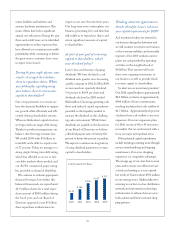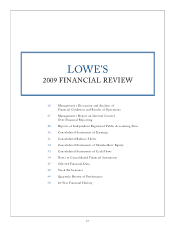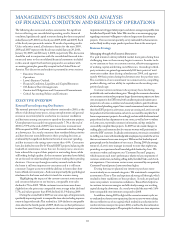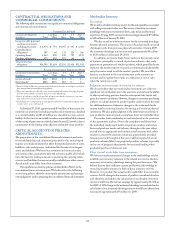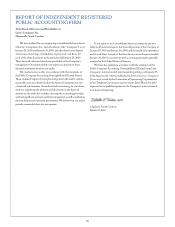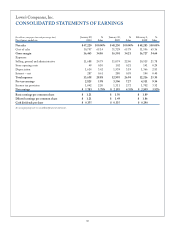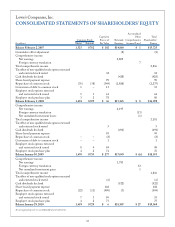Lowe's 2009 Annual Report Download - page 28
Download and view the complete annual report
Please find page 28 of the 2009 Lowe's annual report below. You can navigate through the pages in the report by either clicking on the pages listed below, or by using the keyword search tool below to find specific information within the annual report.
26
Revenue Recognition
Description
See Note 1 to the consolidated financial statements for a discussion
of our revenue recognition policies. e following accounting
estimates relating to revenue recognition require management to
make assumptions and apply judgment regarding the effects of
future events that cannot be determined with certainty.
We sell separately-priced extended warranty contracts under a
Lowe’s-branded program for which we are ultimately self-insured.
We recognize revenues from extended warranty sales on a straight-
line basis over the respective contract term due to a lack of sufficient
historical evidence indicating that costs of performing services
under the contracts are incurred on other than a straight-line basis.
Extended warranty contract terms primarily range from one to four
years from the date of purchase or the end of the manufacturer’s
warranty, as applicable. We consistently group and evaluate extended
warranty contracts based on the characteristics of the underlying
products and the coverage provided in order to monitor for expected
losses. A loss would be recognized if the expected costs of performing
services under the contracts exceeded the amount of unamortized
acquisition costs and related deferred revenue associated with the
contracts. Deferred revenues associated with the extended warranty
contracts increased $70 million to $549 million as of January 29, 2010.
We defer revenue and cost of sales associated with transactions
for which customers have not yet taken possession of merchandise
or for which installation has not yet been completed. Revenue is
deferred based on the actual amounts received. We use historical
gross margin rates to estimate the adjustment to cost of sales for
these transactions. During 2009, deferred revenues associated
with these transactions increased $26 million to $354 million as of
January 29, 2010.
Judgments and uncertainties involved in the estimate
For extended warranties, there is judgment inherent in our evaluation
of expected losses as a result of our methodology for grouping and
evaluating extended warranty contracts and from the actuarial
determination of the estimated cost of the contracts. ere is also
judgment inherent in our determination of the recognition pattern
of costs of performing services under these contracts.
For the deferral of revenue and cost of sales associated with
transactions for which customers have not yet taken possession of
merchandise or for which installation has not yet been completed,
there is judgment inherent in our estimates of gross margin rates.
Effect if actual results differ from assumptions
We have not made any material changes in the methodology used to
recognize revenue on our extended warranty contracts during the
past three years. We currently do not anticipate incurring any losses
on our extended warranty contracts. Although we believe that we
have the ability to adequately monitor and estimate expected losses
under the extended warranty contracts, it is possible that actual
results could differ from our estimates. In addition, if future evidence
indicates that the costs of performing services under these contracts
are incurred on other than a straight-line basis, the timing of revenue
recognition under these contracts could change. A 10% change in the
amount of revenue recognized in 2009 under these contracts would
have affected net earnings by approximately $9 million.
We have not made any material changes in the methodology used
to reverse net sales and cost of sales related to amounts received for
which customers have not yet taken possession of merchandise or
for which installation has not yet been completed. We believe we
have sufficient current and historical knowledge to record reasonable
estimates related to the impact to cost of sales for these transactions.
However, if actual results are not consistent with our estimates or
assumptions, we may incur additional income or expense. A 10%
change in the estimate of the gross margin rates applied to these
transactions would have affected net earnings by approximately
$6 million in 2009.
QUANTITATIVE AND QUALITATIVE
DISCLOSURES ABOUT MARKET RISK
In addition to the risks inherent in our operations, we are exposed to
certain market risks, including changes in interest rates, commodity
prices and foreign currency exchange rates.
Interest Rate Risk
Fluctuations in interest rates do not have a material impact on our
financial condition and results of operations because our long-term
debt is carried at amortized cost and primarily consists of fixed rate
instruments. erefore providing quantitative information about interest
rate risk is not meaningful for financial instruments.
Commodity Price Risk
We purchase certain commodity products that are subject to price
volatility caused by factors beyond our control. We believe that the
price volatility of these products is mitigated by our selling prices
and through fixed-price supply agreements with vendors. e sell-
ing prices of these commodity products are influenced, in part, by
the market price we pay, which is determined by industry supply
and demand.
Foreign Currency Exchange Rate Risk
Although we have international operating entities, our exposure to
foreign currency exchange rate fluctuations is not material to our
financial condition and results of operations.


